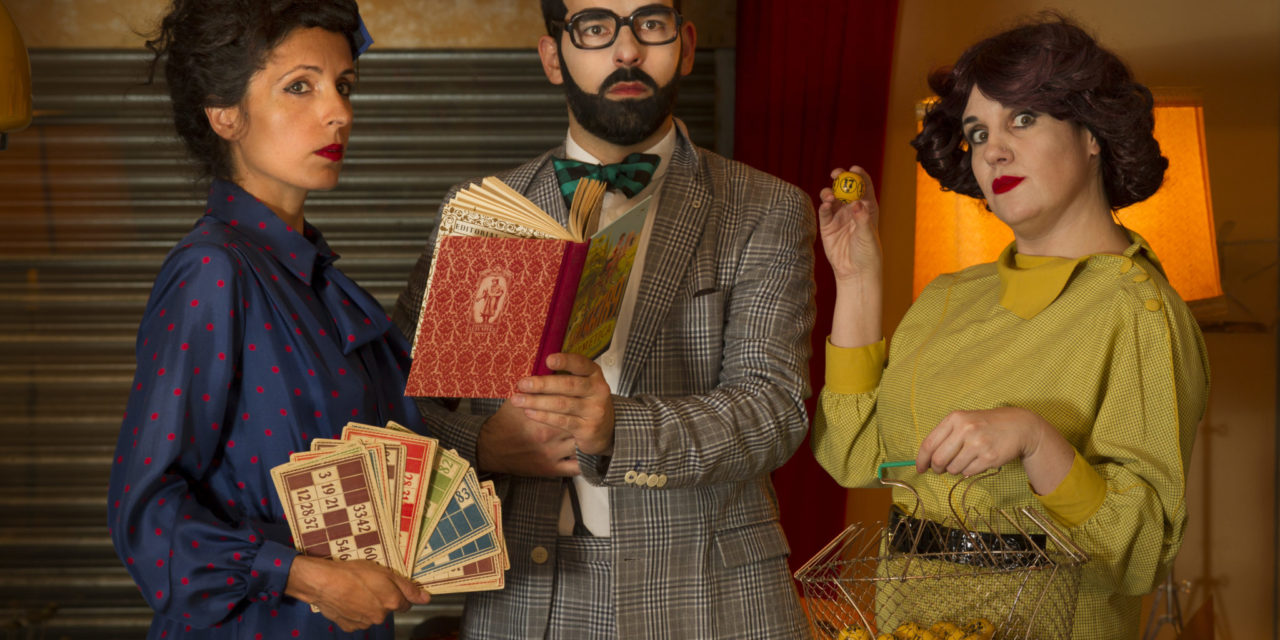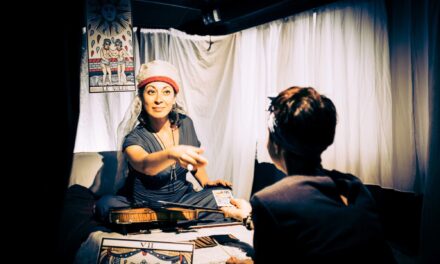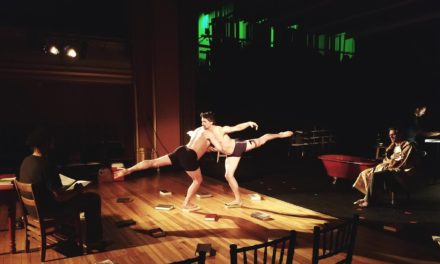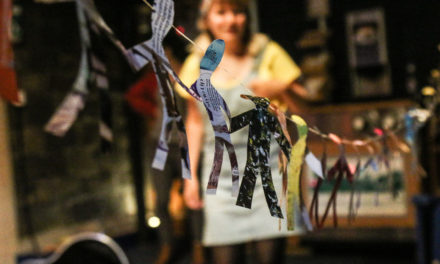There is a place in Madrid well known for the old things that are sold inside. It is an antique shop where one can find past century objects that can only be seen in our imagination or in Belle Époque films. The name of this mysterious shop is Santa y Señora, a place that has been transformed into a theatre space by Sandra Jiménez –playwright, singer and director of Se Traspasa (For Lease). The rest of the cast is composed by Luis Miguel Lucas, musician and actor, and Lorena Toré, actor. Jiménez has created a site-specific theatre piece. Not only is it very unusual for the audience to attend this kind of shows in Spain, but it is also uncommon for theatre entrepreneurs to be interested in them or even flexible at all. Unfortunately, this is also the case with theatre buildings managed by government funds.
Jiménez and her cast have created an immersive experience for the senses, a magical trip for the audience who has the opportunity to participate in the show. The story might be a short one, or even a simple one, but the experience of the participants is unique and original. In this interview, Sandra Jiménez reveals the key elements of her work with the actors, the text, the music and the thrilling past of the building where Se Traspasa is staged.
How did the idea of making a show in a store come up? Did you think of other conventional venues before choosing this one?
The initial idea came from the space itself. We didn’t have the intention to create a new theatre piece at that moment. We just went to have a look at my former drama classmate’s new store. Lorena’s new place had antique and vintage articles, clothing and decorative items, as well as works from different visuals artists. A paradise where old-fashioned objects became the most fashionable items. Furthermore, she had the intention to invite theatre creators and performers to do small pieces there, in order to have a regular theatre program. She wanted to combine both retail and theatre experiences, and the store had a big basement downstairs that could be used for such purpose. Since my partner and I had been investing more time in developing our work as musicians, Lorena suggested that we could do a small concert using the storefront windows. Although the idea was great, it seemed insufficient for us, since the whole place was an amazing venue, full of little evocative details in every corner you looked at. Furthermore, its history was extraordinary. In the early 20s, the store used to be part of one of the most popular theatre venues in Madrid, the Teatro Novedades, which caught fire in 1928 and eventually disappeared.
With such an interesting background, and with all the unique possibilities the place had to offer, Luismi, my partner, immediately came up with the idea: we could create a whole show based on the evocative aspects of the store, in which music would be a very important vehicle, but not the only one. Suddenly it made complete sense for the three of us. We had to make the most of the opportunities the place offered and create a show using all the corners of the location, and see what it would lead us to. So, what came first? Space, unlike other times in which the motor of the work had come from a text, a character, or a theme we wanted to explore in depth. This time, we would devise the piece from the location. It seemed a wonderful beginning.
Did you have artists whose work is in relation with site-specific theatre in mind?
To be honest, and this is the irony of the situation, this kind of theatre practice has always been one of my main interests. I went to London to study drama in 2001, and it was then that I discovered many new forms of theatre. I had studied acting in Madrid, but in London, my studies focused on devising original pieces. I fell in love with Tadeusz Kantor’s theatre, and with his idea of using space in such a deep way. The palimpsest concept was my object of study for a long time (I even started writing my PhD on this matter). In addition, at that time in London, companies like Shunt, Frantic assembly, Forced Entertainment, among many others, were trying to widen the boundaries of theatre practice, exploring the concept of “site-specific theatre.” For a student like me, with such a poor theatre background, finding these companies and practitioners meant a great discovery and unavoidably conditioned my future career. To explain this better I must say that most theatre practice in Spain was at that time (and is still nowadays) mainly based on actors speaking while sitting on a chair or moving without any other aim than “looking natural” in front of an audience whose highest expectation is to understand the “message” of the author.
Having said all this, I think it was pretty clear that I was bound to create a piece of site-specific theatre eventually. However, the irony of this whole matter, as I started saying, is that the initial motor came from my partner, whose knowledge of this theatre practice was very little, and not from myself. It is true, though, that I have led the whole process, written the script, and directed it. It is obvious that this great influence has flourished from my unconscious creative mind. What is there for you will eventually emerge.
Do you think that your proposal comes from a tiredness of the proscenium stage theatre or is it a logical consequence of your quest as an artist?
I guess the real creative soul is in constant search for new ways of expression, which means, in my opinion, new ways to access the human soul. We should keep that thirst for knowledge if we want to produce quality work. In my particular case, it has to do with a political point of view. The theatre world works in the same way society does. There are people who own the places where art is supposed to take place and they can choose what gets done and who by. This way of control also determines the nature of the final product, and surely, its quality and rigor. Sadly, people in charge of managing both private and public theatre venues hardly ever pursue artistic benefits for the community. They usually have two motivations: making money and satisfying their ego. Those two reasons feed the powerful, but never provide a real growth of the human condition. When choosing a venue “outside the establishment” you are sending a clear message to your audience: art can hide in places where you are not told to look for it, but the most amazing experiences in life appear under unexpected shapes. In this way, you are breaking prejudices. You are telling people to open up their minds.
For us, it is very important that people question reality; that they don’t believe everything they are told without hesitation, but search instead for their own truth. And, above all, it is very important for a healthy society to be able to keep an active position in life. We, as artists, refuse to be at home awaiting for the big theatres to call to be able to create. We have the power to conquer our own path and every place, every corner is a source of inspiration. The only thing that can stop us from creating is the thought of impossibility we generate inside our minds. We just need to keep our eyes open, and our minds ready to start working with an audience who is very tired of conventional and boring experiences. We are here to provide new and fresh ways to wake people up from their lethargic lives. It’s our duty.
Although your piece combines music and theatre, it would be very difficult to consider Se Traspasa a musical theatre show. Has it required a great effort to hybridize both disciplines? Or was it something natural considering that Luis Miguel and you are also musicians?
Since the initial idea was to do a concert, music was always very present in the process. We both hate musicals. We don’t think music is really integrated into the dramatic action, and when it is, it’s by pure chance. We are not able to really analyze it from a technical point of view. For this reason, it was a great challenge and we have not fully accomplished yet! It is very important for us that music emerges in a natural way, and communicates as much as any other element. Some songs are in English, and some in Spanish. Sometimes, after the show, some people say it’s a pity that they missed some information because they don’t speak English. I think this is a key element to understand our work. We foster this lack of “understanding” in favor of other aspects that make our audience swim deeper into the music. Music has the power to have a different impact on people’s minds. We tend to think that the only form of real communication, or at least the main one, is through words. However, we are utterly wrong. There are many languages we have not only to communicate our feelings, but also to understand the world in a deeper way. If we only focus on words, we lose a great deal of real understanding. Our goal is to give as much as possible, working with the audience’s unconsciousness. We believe that if you don’t understand the lyrics you are open to understanding other layers. It’s not better or worse. It’s just a different cognitive process. We want our audience to think about it, and above all, to experience it.
In the show, the audience interacts with props (i.e a sheet), did you ever think about including the audience in more ways? Do you consider that the Spanish audience is ready to assume theatrical proposals where more autonomy is required?
People are very concerned about participation when going to see a show “outside the conventions.” Some of our audience members don’t know that the show takes place in a store, so as soon as they discover it, they start fearing. “I don’t want to be intimidated,” they think (as they have confessed to us after the show). We were aware of this common fear beforehand, so we wanted to get the audience involved in the show in the less painful way! We wanted to make them participate without them really being aware of it. The idea that they are part of the dramatic action is a key element to understand their participation. The leasehold of the property makes them straightaway an essential part of this simulation, integrating them in the fiction. From the very beginning, they are the conversational partners of the characters, who address them directly. Even the title Se traspasa (For Lease), which is the main concept of the play, puts them in a crucial position in the show for the development of the storyline.
However, they are free to act in the way they want. Since everything is so unconventional, they keep in a state of wonder during the whole performance, which keeps them active: “Are we going to be standing the whole time? Are we going to be asked? Are we going to have to do something?” However, as the show goes by, and they realize that they are not forced to do anything, they start relaxing. We have always been aware of this, so we decided to create the first part in a more superficial way, based on comedy elements, which will make more sense later, and once the audience is relaxed, increase the intensity. It has all been very thoroughly measured in the rehearsal process. We are all creatures of habit. It is normal that, when something seems different from what we are used to doing or experiencing, our alert mechanisms go off. However, the moment we realize we are out of danger, we relax. It is then that the audience is ready for a stronger message, for the metaphor to be created. We believe all of us need to be shaken from time to time. We need to get used to feeling a little discomfort that will foster our critical thinking. We firmly believe that theatre should be the place to experience it, to train our capacity to question, which is the motor of any important and relevant change in our life and our history. Theatre should be the place to think, in action. Where else?
https://www.youtube.com/watch?v=AvH9n_9yfuw%20
This post was written by the author in their personal capacity.The opinions expressed in this article are the author’s own and do not reflect the view of The Theatre Times, their staff or collaborators.
This post was written by Marcos García Barrero.
The views expressed here belong to the author and do not necessarily reflect our views and opinions.


















